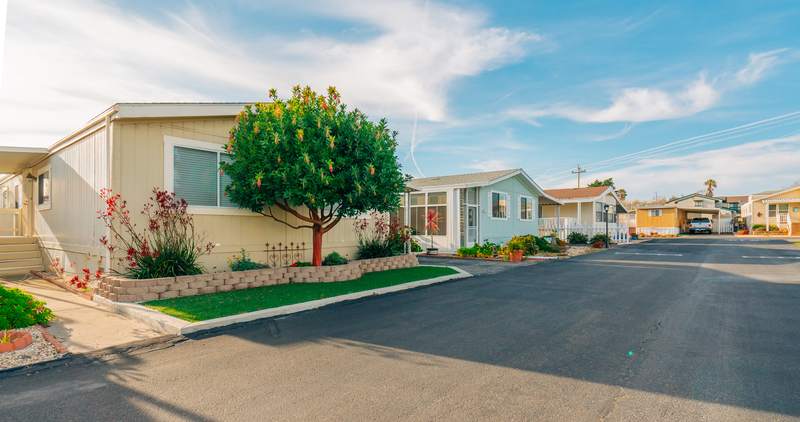Plans to tap your home equity have probably sparked questions about closing costs, interest rates, refinancing and second mortgages. You might also be weighing the pros and cons of a home equity line of credit (HELOC) against a cash-out refinance.
Let’s take a closer look at the ins and outs of a cash-out refinance versus a HELOC so you can make the best decision for your unique situation.
Key Takeaways:
- Cash-out refinancing replaces your existing mortgage with a larger loan, giving you the difference in a lump sum. This can offer lower rates than a HELOC or home equity loan since it’s a first-lien loan.
- A HELOC functions like credit cards secured by your home, offering flexible access to money during a 10-year draw period with variable rates. You pay interest only on the amount you tap.
- A cash-out refinance is best for a large, one-time expense, debt consolidation or when you can improve your loan terms.
- A HELOC is ideal for smaller expenses over time or when you want to preserve your current low-rate mortgage.
Cash-Out Refinance Vs. Home Equity Line Of Credit (HELOC): Basic Overview
A cash-out refinance and a HELOC are mortgage products that turn your home equity – your home’s market value relative to what you owe – into cash. However, they work in very different ways and have separate eligibility requirements. Here is a brief overview:
| Type of Financing | Definition | Maximum Amount of Equity Borrowed | Maximum Debt-To-Income Ratio | Minimum Credit Score |
|---|---|---|---|---|
| Cash-Out Refinance | A refinance mortgage for a larger amount than what’s owed that converts equity into cash | 80% | 50% | 580 – 620+ |
| HELOC | A revolving line of credit that is secured by the borrower’s home equity and tapped as needed | 85% | 43% – 50% | 620 – 660+ |
How Does A Cash-Out Refinance Work?
A cash-out refinance is a new, larger mortgage for more than what you owe that allows you to withdraw the difference into cash. You can use the cash for virtually any purpose, but many homeowners use cash-out refinancing to pay for large, one-time expenses.
Cash-out refi example: Say you owe $100,000 on your mortgage and your home is worth $250,000, giving you $150,000 of equity. Generally, cash-out refinances allow you to turn 80% of your equity into cash (except for VA loans, with which you can access up to 100% of your equity). So, in this example, you could withdraw up to $120,000 through a cash-out refinance.
Requirements
Lenders use three primary criteria to determine eligibility for cash-out refinances:
- Home equity: Lenders look for home buyers to have 15% – 20% equity remaining after the refinance. That means you could use up to 80% of your current equity amount.
- Debt-to-income ratio (DTI): Your DTI measures your gross monthly income against your monthly minimum debt payments. To qualify for a cash-out refinance, your DTI can be a maximum of 50%.
- Credit score: Usually, your credit score must be 620 or higher to qualify for a cash-out refinance, but the higher your score, the more competitive your rate will be. However, if you refinance with a VA loan and you access 90% or less of your equity, you can qualify with a score of 580.
Pros
A cash-out refinance features the main benefits of home equity loans plus several distinctive advantages. The first significant advantage is that you’ll have only one mortgage for your house. As a result, your lender has first payback priority since you don’t have a second mortgage to pay like you would with a home equity loan. In other words, if you go through the foreclosure process, your refinanced mortgage will be paid off before any other mortgages or liens.
Another possible upside is a lower interest rate than those of other home equity products, which could reduce your monthly payment and make your mortgage more affordable in the long run.
A cash-out refinance is also usually the best way to consolidate debt because it’s based on your primary mortgage, so you’re getting the lowest possible mortgage rate for your financial profile. Replacing high-interest credit card debt with mortgage debt can be a financial win because you exchange exorbitant interest rates for a potentially lower mortgage rate.
Lastly, if you use the cash-out refinance to improve your home, your mortgage interest on the withdrawn amount is usually tax deductible.
Cons
A cash-out refinance also has drawbacks. For example, your lender will require you to leave a minimum amount of equity (typically 20%) within the home. Therefore, the part of your equity that’s accessible may not be enough to accomplish your goals, causing you to seek forms of debt that can satisfy your needs but have higher interest rates.
The interest rate on your refinanced mortgage might not be as low as your current rate. For instance, if you bought your house when interest rates were low during the pandemic, a refinance now could increase your interest rate. In that case, leaving your mortgage as is and taking out a second mortgage through a home equity loan or using a HELOC might be more financially sound, depending on your goals for the funds.
Finally, a cash-out refinance has closing costs of 2% – 6% of the loan amount. These can be paid up front or rolled into the loan in exchange for a higher rate.
What’s Your Goal?
Buy A Home
Discover mortgage options that fit your unique financial needs.

Refinance
Refinance your mortgage to have more money for what matters.
Tap Into Equity
Use your home’s equity and unlock cash to achieve your goals.
How Does A Home Equity Line Of Credit Work?
A home equity line of credit (HELOC) turns your equity into a line of credit, meaning you can borrow against it at will instead of receiving a one-time lump sum. Think of a HELOC like a credit card you can access during a specified draw period, typically lasting 5 – 10 years, when you can access as much of your equity as needed.
During the draw period, you’ll pay minimum or interest-only monthly payments on any debt you’ve incurred. When the draw period expires, the repayment period begins, in which you have 10 – 20 years to repay the whole balance.
When discussing home equity financing, you might also hear home equity loans compared to HELOCs. While they also use your equity to secure the loan like HELOCs, home equity loans are actually installment loans that pay out in a single lump sum rather than revolving lines of credit.
Requirements
Each lender has their own HELOC guidelines. To qualify in most cases, you’ll need to meet these requirements:
- You need more than 15% equity in your home based on its current value. And most lenders allow borrowers to use only up to 85% of their equity, but this can vary by lender.
- Your DTI typically cannot exceed 43%, though some lenders may allow up to 50%.
- Your credit score should be 620 – 660 or higher. The higher your score, the better your HELOC rates will be.
Pros
You can use the funds for any purpose, though experts recommend withdrawing only what you need over time. Additionally, your interest payments are tax deductible if you use the money for improvements or additions to your home.
A HELOC also gives you more control over your equity so that you only borrow what you need. Borrowing as you go results in a lower total debt than a home equity loan or cash-out refinance, which are paid in one lump sum.
Repayment for a HELOC is also less stringent because the first 5 – 10 years require interest payments only. This results in lower expenses during the first part of the loan.
Cons
A HELOC isn’t suitable for every situation. First, since it turns your equity into a revolving line of credit, a HELOC makes less sense if you have a sole, giant expense you can’t afford. A home equity loan or cash-out refinance can give you the lump sum needed.
Also, your lender might stipulate specific minimum withdrawals during the draw period, forcing you to borrow more money than you need. The costs of a HELOC can also increase because of expenses such as closing costs, maintenance fees, early payoff fees, inactivity fees and transaction fees.
A HELOC typically has a variable interest rate. The adjustments might raise your interest rate and make your monthly payments expensive and make budgeting harder.
Ready to Refinance?
Get matched with a lender that can help you reach your financial goals.
Cash-Out Refinance Vs. HELOC: 2025 Market Overview
While home values have surged in recent years, rising mortgage rates have changed how homeowners think about tapping their equity.
HELOC balances in the U.S. rose by $9 billion as of the second quarter 2025, with total outstanding HELOC balances at $411 billion, according to the Federal Reserve Bank of New York. That’s a lot of equity sitting in American homes.
And homeowners are increasingly turning to equity for relief. Since 2023, two new HELOCs have been opened for every new mortgage originated, with an average HELOC balance of $45,157 in 2024, Experian research found. This is because many homeowners are locked into ultra-low, pandemic-era mortgage rates of 2% – 4%. Trading those sweet, low rates for today’s much-higher cash-out refi rates above 7% doesn’t make financial sense. Instead, they’re turning to HELOCs.
By the end of 2023, nearly 70% of mortgages outstanding in the U.S. were 3 percentage points lower than the rates at that time, according to the Federal Reserve Bank of New York. The bottom line: If you have a super-low rate on your first mortgage, you might consider a HELOC or home equity loan to tap equity instead of a cash-out refi.
View Your Refinancing Options
Find a refinance lender that will work with your unique situation.
Current Cash-Out Refinance Rates Vs. HELOC Rates
Let’s look at the numbers. Interest rates determine how much your loan will cost you.
Current Cash-Out Refinance Rates
Cash-out refi rates typically run 0.25% – 0.50% higher than standard mortgage rates because you’re taking out a larger loan balance. As of August 2025, that puts most cash-out refinance rates in the 7.25% – 7.75% range for well-qualified borrowers.
Current HELOC Rates
The national average HELOC interest rate is 8.27% as of August 2025, according to data from Curinos. That’s down from recent highs. The average APR for a HELOC has gradually fallen since the beginning of 2025, when it was closer to 9%.
How These Rates Are Determined
Contrary to popular belief, mortgage rates are determined by movements in the 10-year Treasury rather than the federal funds rate, though the latter has an indirect influence on mortgage rates. And because a cash-out refinance is a fixed-rate mortgage, the rate you get when you close is the rate you’ll have over the loan’s lifetime.
However, variable HELOC rates are tied to the prime rate. When the Federal Reserve cuts (or hikes) rates, HELOC rates typically follow those movements and can fluctuate with market conditions.
A Third Option: Home Equity Loans
There’s a third option worth considering if you want to tap your home equity: home equity loans. They’re like the middle ground between cash-out refinances and HELOCs.
Here’s how home equity loans work: You borrow a lump sum against your home’s equity, just like a cash-out refinance. However, you get to keep your existing mortgage (and that nice, low rate). The drawback is this type of loan typically has a higher rate than a cash-out refi, and you’ll have to repay the principal and interest on day 1 versus interest-only payments on a HELOC.
Both home equity loans and HELOCs are second-lien mortgages, meaning they come behind your primary home loan in the repayment pecking order. And both options are tax deductible if you use the funds to improve your home. If you use the money for other reasons like debt consolidation or paying your child’s college tuition, you’ll lose the mortgage interest deduction.
Here’s a side-by-side comparison of how home equity loans and HELOCs work.
| Loan Feature | Home Equity Loan | HELOC |
|---|---|---|
| Disbursement | Lump sum at closing | Draw as needed during 10-year period |
| Interest rate | Fixed (around 8% – 9% in 2025) | Variable (8.12% average in 2025) |
| Monthly payments | Fixed principal + interest from day 1 | Interest-only during draw period, then balance in repayment period |
| Repayment term | 5 – 30 years | 10-year draw + 10- to 20-year repayment (20 – 30 years total) |
| Best for | One-time large expense | Smaller expenses over time |
| Rate changes | Fixed | Variable (rates can fluctuate) |
| Access to money | Upfront lump sum | Ongoing access during draw period, like a credit card |
| Closing costs | 2% – 6% of loan amount | 2% – 6% of loan amount |
| Reusability | Cannot reborrow what you pay back | Can reborrow (up to credit limit) during draw period |
HELOC Vs. Cash-Out Refi: Similarities And Differences
Although HELOCs and cash-out refinancing have key differences, they share numerous similarities, such as:
- Because both use your equity as collateral, you risk foreclosure if you can’t afford the payments on them and default on the loans.
- Your interest is tax deductible if you use the funds for home improvements or additions.
- Both usually require you to leave 15% – 20% of your equity untouched.
- You’ll pay closing costs based on the total loan amount.
- You can use funds in any way you wish.
- You’ll likely receive a lower interest rate than you would on a personal loan or credit card.
- Lenders have similar DTI and credit requirements for both, although a cash-out refi gives more flexibility with a VA loan.
On the flip side, here is how HELOCs and cash-out refinances differ:
- A cash-out refi usually has a fixed interest rate, while a HELOC has a variable rate.
- You’ll receive a lump sum from a cash-out refinance instead of a line of credit that you can access for several years.
- If you refinance with a VA or FHA loan, your lender will likely have less strict financial requirements than those of a HELOC.
- A VA cash-out refinance may give you access to 100% of your equity.
- You’ll have one mortgage after your cash-out refi, whereas a HELOC will create a line of credit you’re responsible for on top of your existing mortgage.
- A cash-out refinance might have higher closing costs than a HELOC, but you can also roll them into your new loan amount if necessary.
How To Choose Between A Cash-Out Refinance And A HELOC
If you’re stuck when deciding between using a cash-out refinance or HELOC to access your equity, consider the following steps:
- Calculate your equity. Since the amount of equity you have in your home determines your loan amount, you should first find out how much equity is available. If you need to use as much equity as possible, a HELOC could give you more cash on hand.
- Check interest rates. Next, look at the rate for your existing mortgage compared to market rates. If you think you can get a lower interest rate, a cash-out refinance may be the best option. If you are looking to pay off other high-interest debt, even a rate that’s similar to your existing mortgage rate is a smart move. For example, let’s say you have $10,000 of credit card debt with a 20% interest rate and a $10,000 auto loan with an 8% interest rate. A cash-out refinance with a 6% interest rate will allow you to pay off your debts and leave you with a new mortgage that is $20,000 higher than before, plus closing costs. The monthly payment for your new mortgage will be significantly less expensive than payments on your original loan plus your high-interest debts. However, if interest rates are higher than when you got your mortgage, a HELOC could be a better choice.
- Consider different loan terms. Think about how long you want to repay the equity you’ve borrowed. A cash-out refinance pays off your existing mortgage and can give you more time to repay your loan while HELOCs can come with shorter repayment periods.
- Determine your desired funding time. Because funding via a cash-out refinance is a single lump sum, it may take less time to access your equity. HELOCs allow you to access a specific amount of equity over several years, meaning you can withdraw money periodically based on your needs. For instance, you might have three home improvement projects to complete over the next 10 years. You plan on doing one job at a time and figure they will take no more than $50,000 combined. You can take on one project at a time and pay only what’s necessary using a HELOC with a 10-year draw period. You’ll access your equity as a revolving line of credit for each project instead of sitting on a lump sum you need to start repaying immediately. At the end of the draw period, you’ll repay only the funds you used. The downside is that it takes longer to convert all your equity.
- Estimate your closing costs. How much can you afford to pay in closing costs? Remember, closing costs for a cash-out refinance are usually higher than those for a HELOC, but you can roll them into the new mortgage.
Frequently Asked Questions
Here’s an example: On a $400,000 home with a $200,000 mortgage, you could potentially access up to $120,000 with cash-out refinancing or up to $140,000 with a HELOC.
The Bottom Line: Both Options Tap Home Equity
A cash-out refinance and a HELOC both allow you to turn your equity into cash for any financial needs. In addition, both have similar financial requirements and provide tax deductions if you use the funds for home improvements.
However, a cash-out refinance is best for large, singular expenses and can provide lower interest rates. Meanwhile, a HELOC transforms equity into revolving credit you can access repeatedly. Just keep in mind that a HELOC typically also has a variable interest rate, making your monthly payments harder to budget.

Deborah Kearns
Deborah Kearns is an award-winning independent journalist with more than 15 years of experience covering real estate, mortgages and personal finance. Her work has appeared in the Wall Street Journal, Kiplinger, U.S. News & World Report, Quartz, CNN, Forbes, Fortune, Newsweek, The Associated Press and dozens of other outlets. She previously led content and communications at a Top 15 national mortgage company and held writing and editing roles at Bankrate, NerdWallet, LendingTree and RE/MAX. She holds a bachelor's degree in journalism from the University of Florida and a master's degree in public relations from Ball State University.












